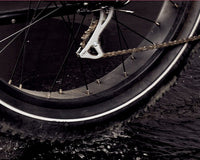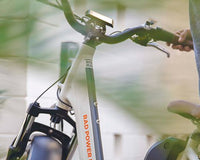For as long as cycling has been a sport, riders have always looked for that edge that is going to give them the advantage they need to push harder, ride faster, and finish sooner. Up until fairly recently, this meant getting as thin of tires as possible, which makes sense. The lower the rolling resistance, the faster and more efficient the bike is, the faster the rider will finish the race. Right? Believe it or not, recent developments in bike technology show that tires that give the rider a little more cushion and traction and, depending on the discipline, the ability to ride through loose and unstable conditions, will lead to faster commute times.
Traction, Traction, and More Traction
One of the biggest advantages of having a wider tire is having more rubber on the ground, letting the rider carry more speed into corners and brake later. What this means for the average rider is that wider tires will allow you to have more confidence when turning and confidence knowing that you can stop your bike when you need to.
This shift has been most noticeable in the mountain biking world. In downhill mountain biking, traction is the name of the game, from full suspension bikes designed to make sure your wheels are on the ground as much as possible to big knobby tires making sure your bike never slides out from under you in the corners. Mountain bike tires have gone from the 1.95-inch tires of the 90’s to now reaching sizes of 3-inches across. As a result, riders are taking turns faster and even braking later because they know that with that much more rubber on the ground, they can stop whenever they need. This has carried into the ebike world with bikes like the RadRover that are built to handle some of the most difficult conditions, whether it be descending gravel roads in the mountains around Seattle or navigating the frozen roads of the Midwest, the 4-inch tires are going to keep the bike underneath you and remain predictable even if the conditions aren’t.
Air-Ride Suspension
Let’s compare this on your regular commuter bike. As an example, about twice a week I will commute on my road bike which has a “generous” 1.25-inch tire and I will typically have 95-105 psi. Compare that to my RadWagon that has 2.3-inch tires that I will typically keep around 60-65 psi. While my road bike is extremely efficient and zippy, my tailbone definitely appreciates the cushion it gets from the RadWagon. When I hop on the RadWagon, I find myself double checking to make sure I’m actually on a bike and not just floating down the road!
What is a fat bike?
One of the newest trends to come to the bike world is the fat bike. With 4-inch to 5-inch tires, they really do feel like a monster truck and can take you through places that you could never take a traditional mountain bike. These tires were originally designed to ride through soft sand and snow. This works well because the large surface area allows you to stay higher in the soft terrain and maintain traction, but the downside of these super-sized tires is the increased rolling resistance. For this reason, fat bikes have become much more popular but still remained somewhat of a niche in the biking world. The exception to this, though, is with ebikes where fat tires are extremely popular. Ebikes can easily overcome the increased rolling resistance of fat tires and the assistance from the motor makes riding through loose terrain less of a chore and more pure fun.
This became especially helpful when I was out in Montana during the winter. We had just received a fresh snowfall and so we pulled out a couple of RadRovers and rode all over town! Instead of sinking into the snow and just getting stuck, we were able to ride along the top and cruise through town and in and out of the snowdrifts. To this day, that was the most fun I have ever had on a bike.
As with anything, trends come in and out of style. But one thing is sure: comfort, confidence, and big tires are here to stay. With the electric assist to help you overcome the long feared rolling resistance, there is nothing stopping you and your next adventure!








